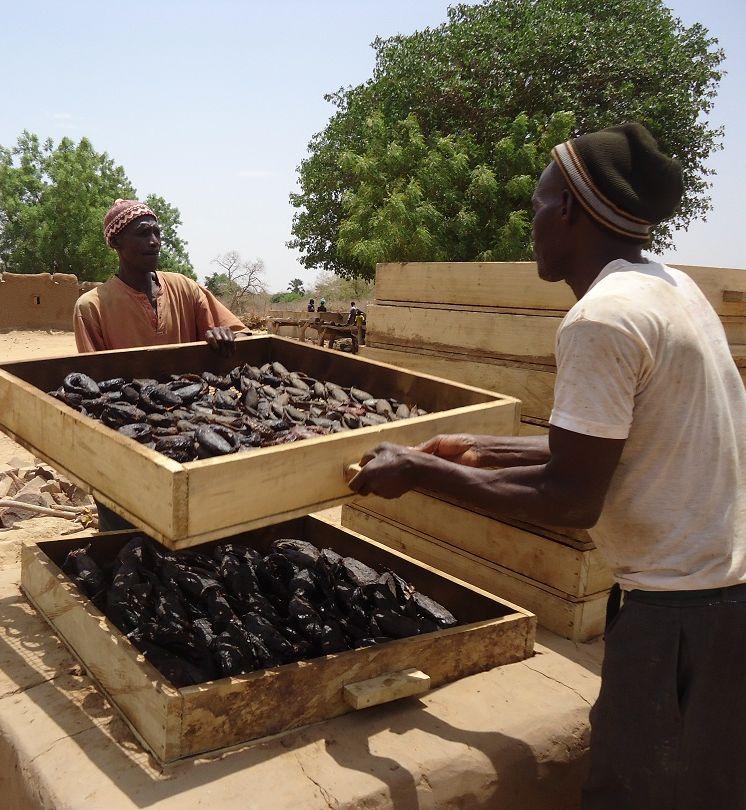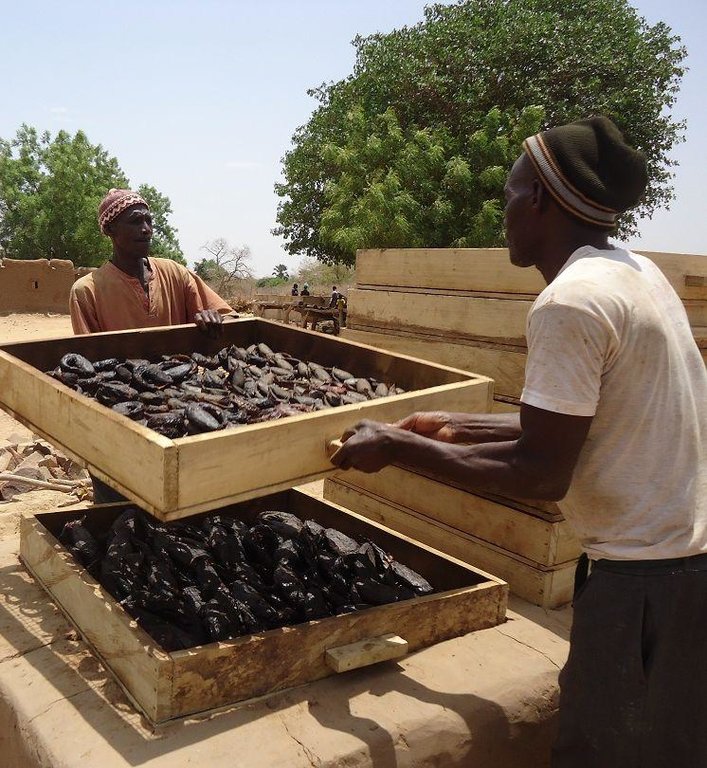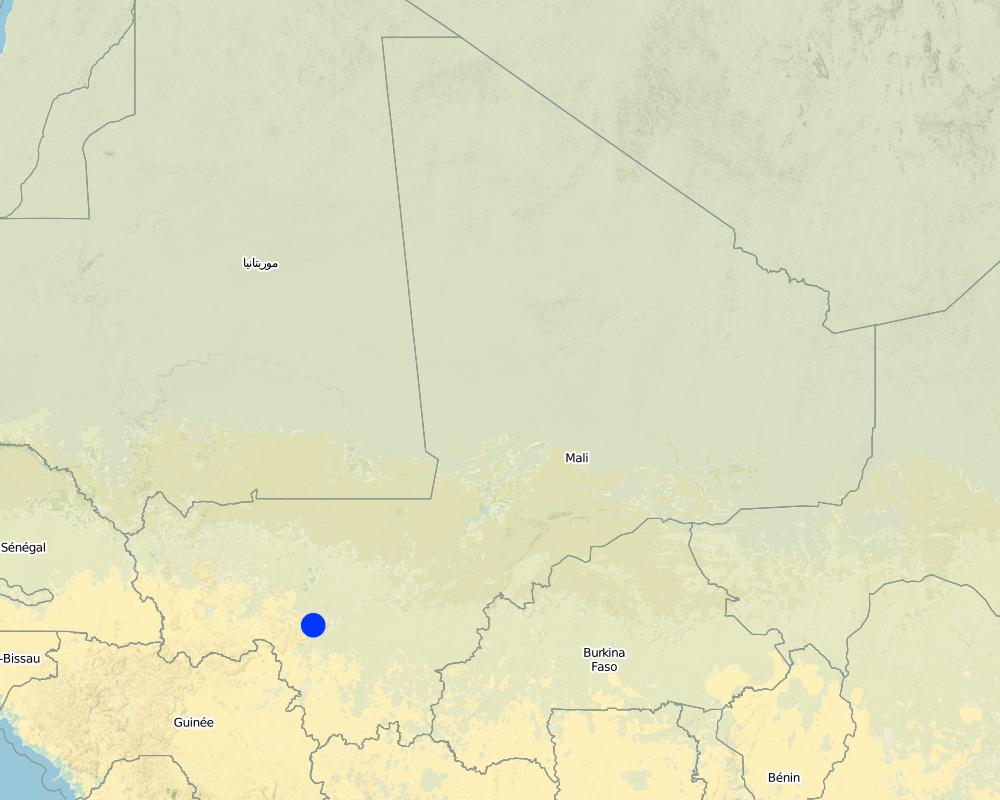Fish farming as a way of adding value to dam schemes [马里]
- 创建:
- 更新:
- 编制者: Dieter Nill
- 编辑者: –
- 审查者: Fabian Ottiger, Alexandra Gavilano
Pisciculture comme moyen de valorisation des barrages (French)
technologies_1648 - 马里
查看章节
全部展开 全部收起1. 一般信息
1.2 参与该技术评估和文件编制的资源人员和机构的联系方式
SLM专业人员:
Kone Mamadou Gallo
IPRO-DB Bélédougou
马里
SLM专业人员:
Schneider Ralf
IPRO-DB Bélédougou
马里
SLM专业人员:
Ouologuem Abass
IPRO-DB Bélédougou
马里
有助于对技术进行记录/评估的项目名称(如相关)
Manual of Good Practices in Small Scale Irrigation in the Sahel (GIZ )有助于对技术进行记录/评估的机构名称(如相关)
Deutsche Gesellschaft für Internationale Zusammenarbeit (GIZ) GmbH (GIZ) - 德国1.3 关于使用通过WOCAT记录的数据的条件
编制者和关键资源人员接受有关使用通过WOCAT记录数据的条件。:
是
1.4 所述技术的可持续性声明
这里所描述的技术在土地退化方面是否存在问题,导致无法被认为是一种可持续的土地管理技术?:
否
2. SLM技术的说明
2.1 技术简介
技术定义:
Introduction of fish species suited to dam reservoirs
2.2 技术的详细说明
说明:
The objective of stocking reservoirs with fish is to add value to dam schemes through artisanal fish farming and an increase in fish production.
Purpose of the Technology: This helps to improve the quality of local people’s diets and increases incomes. The technique combines fish farming and agriculture.
The low investment costs and high profitability of the activity are very attractive. The juvenile fish are available prior to each forthcoming season and local management of the scheme is easy.
Establishment / maintenance activities and inputs: The beneficiaries are guided through the process of setting up a fish farming management committee. The committee is tasked with the internal monitoring of activities to implement artisanal fish farming, while the project team takes care of external monitoring.
Implementation: organise an exchange visit between a village with experience operating this type of scheme, and the beneficiary village; train beneficiaries in artisanal fish farming; stock reservoirs with fish; care for and feed the fish; provide training on techniques used to catch and process fish (smoking and drying); construct breeding ponds; maintain a stock of fingerlings for the next season. Fish suited to both rice growing environments and fish farming should be selected. A stock of fingerlings must be maintained in breeding ponds following fish harvesting.
Roles of the actors involved: the support structure (IPRO-DB) helps with the purchase of fingerlings, builds the capacity of producers, carries out monitoring, connects technical services with traders, equips associations with fishing materials and monitoring tools, and provides support in the presentation of results at village meetings. The village committee monitors implementation (feeding, caretaking and sales) and reports on results following activities. Private sector fish farming specialists provide advisory support (fish stocking, controlling parameters, training) and monitor implementation. Merchants buy the output. The commune conducts external monitoring and provides advisory support.
2.3 技术照片
2.5 已应用该技术的、本评估所涵盖的国家/地区/地点
国家:
马里
区域/州/省:
Mali
有关地点的进一步说明:
Kambila, Nonkon, Kolokani
具体说明该技术的分布:
- 适用于特定场所/集中在较小区域
注释:
Sonikegny village, Kambila Commune
Nonkon village, Nonkon Commune
Tiembougou village, Kolokani Commune
Korokabougou village, Kolokani Commune
5,000 people
Map
×2.6 实施日期
如果不知道确切的年份,请说明大概的日期:
- 不到10年前(最近)
2.7 技术介绍
详细说明该技术是如何引入的:
- 通过项目/外部干预
注释(项目类型等):
Since 2009, implemented by IPRO-DB
3. SLM技术的分类
3.1 该技术的主要目的
- 改良生产
- 创造有益的经济影响
3.2 应用该技术的当前土地利用类型
同一土地单元内混合使用的土地::
是
具体说明混合土地使用(作物/放牧/树木):
- 农牧业(包括农牧结合)

农田
- 一年一作
- rice
每年的生长季节数:
- 1
具体说明:
Longest growing period in days: 120, Longest growing period from month to month: August-November

牧场
注释:
Major land use problems (compiler’s opinion): low fish production
Livestock density: 1-10 LU /km2
3.4 供水
该技术所应用土地的供水:
- 混合雨水灌溉
3.5 该技术所属的SLM组
- Fish farming
3.6 包含该技术的可持续土地管理措施

管理措施
- M5:物种组成的控制/变化
3.7 该技术强调的主要土地退化类型

生物性退化
- Bh:栖息地丧失
- Bs:质量和物种组成/多样性的下降
3.8 防止、减少或恢复土地退化
具体数量名该技术与土地退化有关的目标:
- 修复/恢复严重退化的土地
4. 技术规范、实施活动、投入和成本
4.1 该技术的技术图纸
技术规范(与技术图纸相关):
Technical knowledge required for field staff / advisors: moderate
Technical knowledge required for land users: low
Main technical functions: spatial arrangement and diversification of land use, increase in fish production
Control / change of species composition: stocking reservoirs with fish, combines fish farming and agriculture
4.3 技术建立活动
| 活动 | 时间(季度) | |
|---|---|---|
| 1. | organise an exchange visit between a village with experience operating this type of scheme, and the beneficiary village | |
| 2. | train beneficiaries in artisanal fish farming; | |
| 3. | stock reservoirs with fish | |
| 4. | care for and feed the fish | |
| 5. | provide training on techniques used to catch and process fish (smoking and drying); | |
| 6. | construct breeding pods |
4.5 维护/经常性活动
| 活动 | 时间/频率 | |
|---|---|---|
| 1. | maintain a stock of fingerlings for the next season |
5. 自然和人文环境
5.1 气候
年降雨量
- < 250毫米
- 251-500毫米
- 501-750毫米
- 751-1,000毫米
- 1,001-1,500毫米
- 1,501-2,000毫米
- 2,001-3,000毫米
- 3,001-4,000毫米
- > 4,000毫米
农业气候带
- 半干旱
Thermal climate class: tropics
5.2 地形
平均坡度:
- 水平(0-2%)
- 缓降(3-5%)
- 平缓(6-10%)
- 滚坡(11-15%)
- 崎岖(16-30%)
- 陡峭(31-60%)
- 非常陡峭(>60%)
地形:
- 高原/平原
- 山脊
- 山坡
- 山地斜坡
- 麓坡
- 谷底
垂直分布带:
- 0-100 m a.s.l.
- 101-500 m a.s.l.
- 501-1,000 m a.s.l.
- 1,001-1,500 m a.s.l.
- 1,501-2,000 m a.s.l.
- 2,001-2,500 m a.s.l.
- 2,501-3,000 m a.s.l.
- 3,001-4,000 m a.s.l.
- > 4,000 m a.s.l.
5.3 土壤
平均土层深度:
- 非常浅(0-20厘米)
- 浅(21-50厘米)
- 中等深度(51-80厘米)
- 深(81-120厘米)
- 非常深(> 120厘米)
土壤质地(表土):
- 中粒(壤土、粉土)
- 细粒/重质(粘土)
表土有机质:
- 中(1-3%)
- 低(<1%)
如有可能,附上完整的土壤描述或具体说明可用的信息,例如土壤类型、土壤酸碱度、阳离子交换能力、氮、盐度等。:
Soil fertility: Medium
Soil drainage/infiltration: Medium and poor
Soil water storage capacity: Medium
5.4 水资源可用性和质量
地下水位表:
5-50米
地表水的可用性:
中等
水质(未处理):
仅供农业使用(灌溉)
关于水质和水量的注释和进一步规范:
Availability of surface water: Also poor/ none
5.5 生物多样性
物种多样性:
- 中等
栖息地多样性:
- 中等
关于生物多样性的注释和进一步规范:
Species diversity: medium, low
5.6 应用该技术的土地使用者的特征
生产系统的市场定位:
- 混合(生计/商业)
非农收入:
- 收入的10-50%
相对财富水平:
- 贫瘠
- 平均水平
机械化水平:
- 手工作业
性别:
- 男人
说明土地使用者的其他有关特征:
Population density: < 10 persons/km2
Annual population growth: 2% - 3%
10% of the land users are rich.
50% of the land users are average wealthy.
30% of the land users are poor.
10% of the land users are poor.
5.7 应用该技术的土地使用者使用的平均土地面积
- < 0.5 公顷
- 0.5-1 公顷
- 1-2 公顷
- 2-5公顷
- 5-15公顷
- 15-50公顷
- 50-100公顷
- 100-500公顷
- 500-1,000公顷
- 1,000-10,000公顷
- > 10,000公顷
这被认为是小规模、中规模还是大规模的(参照当地实际情况)?:
- 小规模的
5.8 土地所有权、土地使用权和水使用权
注释:
The irrigated land is allocated by the chief
5.9 进入服务和基础设施的通道
健康:
- 贫瘠
- 适度的
- 好
教育:
- 贫瘠
- 适度的
- 好
技术援助:
- 贫瘠
- 适度的
- 好
就业(例如非农):
- 贫瘠
- 适度的
- 好
市场:
- 贫瘠
- 适度的
- 好
能源:
- 贫瘠
- 适度的
- 好
道路和交通:
- 贫瘠
- 适度的
- 好
饮用水和卫生设施:
- 贫瘠
- 适度的
- 好
金融服务:
- 贫瘠
- 适度的
- 好
6. 影响和结论性说明
6.1 该技术的现场影响
社会经济效应
生产
产品多样性
收入和成本
农业收入
收入来源的多样性
其它社会经济效应
Fish production
社会文化影响
食品安全/自给自足
健康状况
Improved livelihoods and human well-being
注释/具体说明:
Helps to improve the quality of local people’s diets and increases incomes. The technique combines fish farming and agriculture.
生态影响
生物多样性:植被、动物
动物多样性
6.3 技术对渐变气候以及与气候相关的极端情况/灾害的暴露和敏感性(土地使用者认为的极端情况/灾害)
渐变气候
渐变气候
| 季节 | 增加或减少 | 该技术是如何应对的? | |
|---|---|---|---|
| 年温度 | 增加 | 好 |
气候有关的极端情况(灾害)
气象灾害
| 该技术是如何应对的? | |
|---|---|
| 局地暴雨 | 好 |
| 局地风暴 | 好 |
气候灾害
| 该技术是如何应对的? | |
|---|---|
| 干旱 | 不好 |
水文灾害
| 该技术是如何应对的? | |
|---|---|
| 比较和缓的(河道)洪水 | 好 |
其他气候相关的后果
其他气候相关的后果
| 该技术是如何应对的? | |
|---|---|
| 缩短生长期 | 好 |
6.4 成本效益分析
技术收益与技术建立成本相比如何(从土地使用者的角度看)?
短期回报:
非常积极
长期回报:
非常积极
技术收益与技术维护成本/经常性成本相比如何(从土地使用者的角度看)?
短期回报:
非常积极
长期回报:
非常积极
6.7 该技术的优点/长处/机会
| 编制者或其他关键资源人员认为的长处/优势/机会 |
|---|
| The technique increases fish production, improves beneficiaries’ diets and raises incomes. |
| The low investment costs and high profitability of the activity are very attractive |
| The juvenile fish are available prior to each forthcoming season |
| Local management of the scheme is easy |
6.8 技术的弱点/缺点/风险及其克服方法
| 编制者或其他关键资源人员认为的弱点/缺点/风险 | 如何克服它们? |
|---|---|
| Few species of fish are suited to both rice growing environments and fish farming | |
| Water availability for at least six months from September |
7. 参考和链接
7.1 信息的方法/来源
- 实地考察、实地调查
- 与土地使用者的访谈
(现场)数据是什么时候汇编的?:
01/07/2012
7.2 参考可用出版物
标题、作者、年份、ISBN:
Fish farming report and accounts
标题、作者、年份、ISBN:
Monitoring report for the ‘Boubacar DIALLO’ fish farm
7.3 链接到网络上的相关信息
标题/说明:
Manual of Good Practices in Small Scale Irrigation in the Sahel. Experiences from Mali. Published by GIZ in 2014.
URL:
http://star-www.giz.de/starweb/giz/pub/servlet.starweb
链接和模块
全部展开 全部收起链接
无链接
模块
无模块




